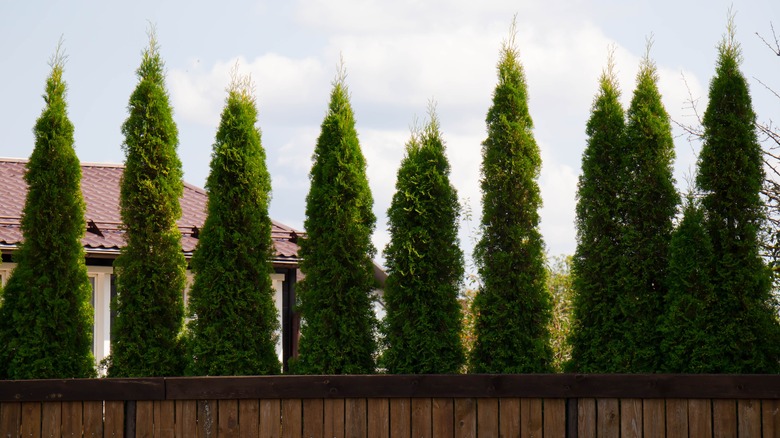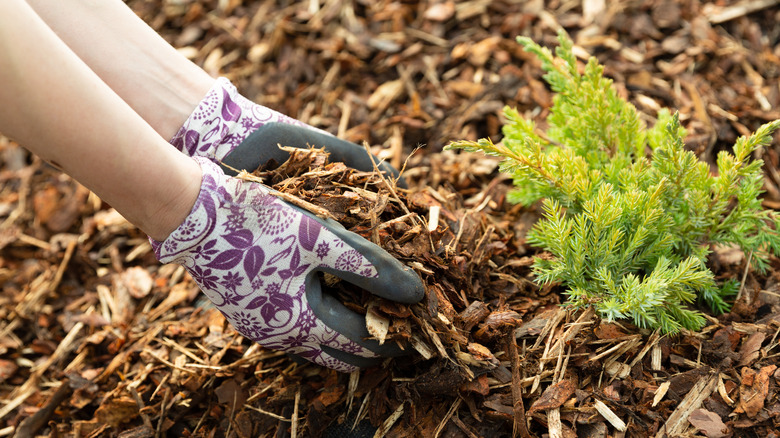How To Plant A Fast-Growing Taylor Juniper Tree For Outdoor Privacy
Planting trees is one of the best ways to make your backyard feel more private. The first step is picking the right tree, and one of the most popular choices is the 'Taylor' juniper (Juniperus virginiana Taylor). With their tall, slender shape and evergreen foliage, 'Taylor' juniper trees make a great outdoor privacy screen for your garden that lasts year-round. You can plant one on its own or plant a row of the evergreen trees to create a privacy screen in any site that gets direct sunlight — ideally full sun, but they will tolerate part sun. 'Taylor' juniper trees are one of the fastest-growing trees to plant for privacy. This eastern red cedar cultivar has a medium growth rate (growing up to 2 feet per year) so you can have a full and vibrant privacy tree or hedge in just a few years.
Because this cultivar maxes out at about 20 to 25 feet tall and just 3 to 4 feet wide, it's also a great choice for gardeners who don't want a tree that eventually towers over their home. It will remain a relatively compact and tidy privacy screen throughout its life — with little ongoing maintenance required once established. It's also adaptable to a wide variety of climates, as it's capable of growing in hardiness zones 4 to 9. Just be sure to choose a planting site based on the tree's mature size and take good care of your new 'Taylor' juniper while it's getting established.
Tips for planting 'Taylor' juniper trees for privacy
For best results, plant new trees in the fall. The soil is still warm but air temperatures have cooled so the tree loses less water. The cooler temperatures also trigger the tree to focus more on developing its roots than putting out new growth above ground. Another key to success is choosing the right site. If the ideal location to provide maximum privacy doesn't have the ideal growing conditions for your tree, you might need to get creative. 'Taylor' juniper trees are adaptable, but they prefer full sun (at least six hours) and well-drained soil. If the soil is too wet, try some useful drainage solutions like using soil amendments to improve drainage.
Now, it's time to dig. Your hole should be twice as wide and about as deep as the root ball of your tree. If planting multiple trees for a hedge, space holes about 6 feet apart. Before planting, loosen and spread the roots of your tree. Then, place it in the hole so that the top edge of the root ball is level with or slightly higher than the top of your hole. If needed, you can backfill until the top of the root ball is level with the top of the hole when you set the tree inside. While holding the tree upright, fill the hole with the soil you just dug out. Soak the area with water and then apply a layer of mulch around the tree.
Caring for your new 'Taylor' juniper
For the first year or so after planting, you'll need to take care of your 'Taylor' juniper to ensure it can get established and thrive in its new home. To start, keep it well-hydrated all year round — unless the ground is frozen. It should get at least 2 inches of water per week for the first three years. In weeks where you get less than 2 inches of rain, supplement by watering. You should also keep a 3-inch layer of mulch around your new tree. Top it off with fresh mulch as needed to keep the layer thick enough, but be careful not to pile the mulch right up against the trunk. Keeping a small gap between the mulch line and the trunk helps prevent rot.
When you water your tree, be sure to observe it. Check for signs of stress or improper watering so you can properly modify your schedule. You can also check for signs of disease to tackle the problem before it gets out of hand. While 'Taylor' junipers are pretty hardy and relatively problem-free, they can sometimes experience cedar apple rust — a type of fungal infection that typically appears on the twigs during winter and looks like rusty bumps. To combat this, spray the plant with a copper fungicide a few times a week from late summer to the end of October. If signs of infection persist, call a professional to learn how to treat it.


